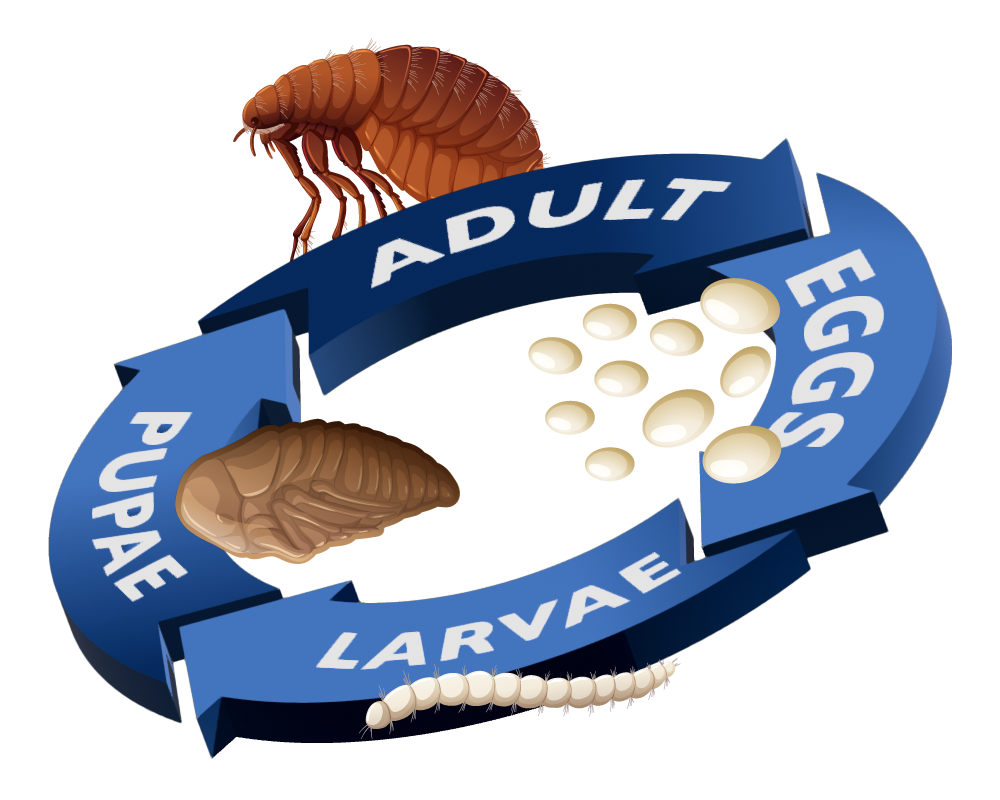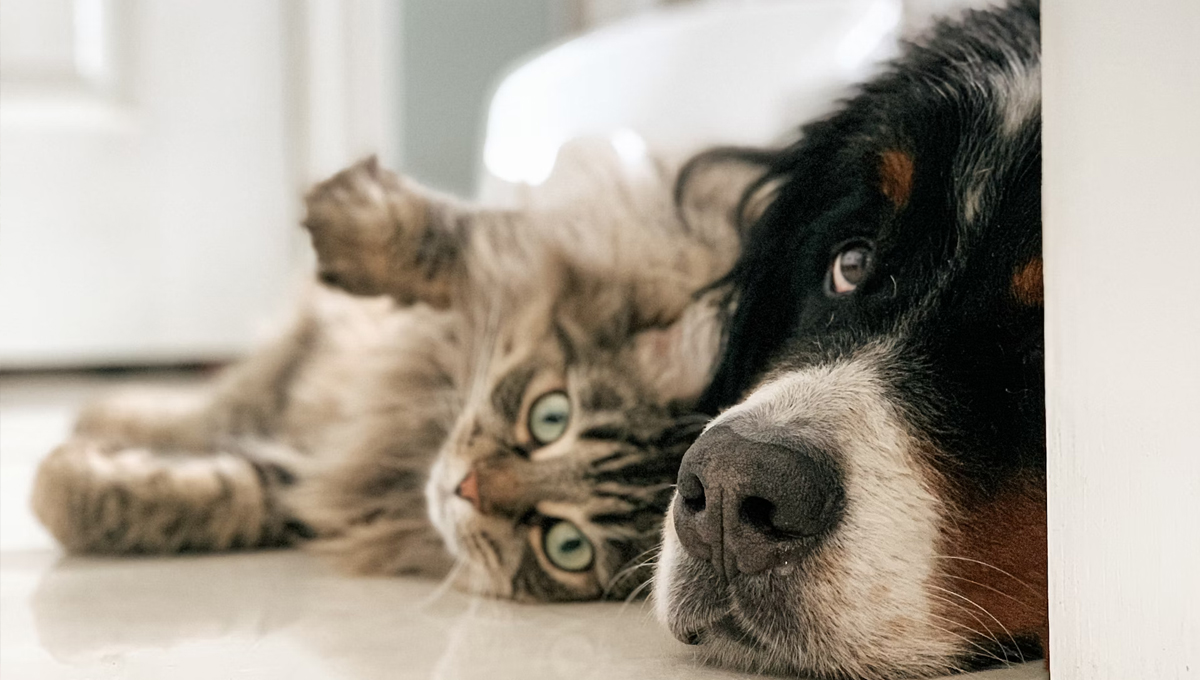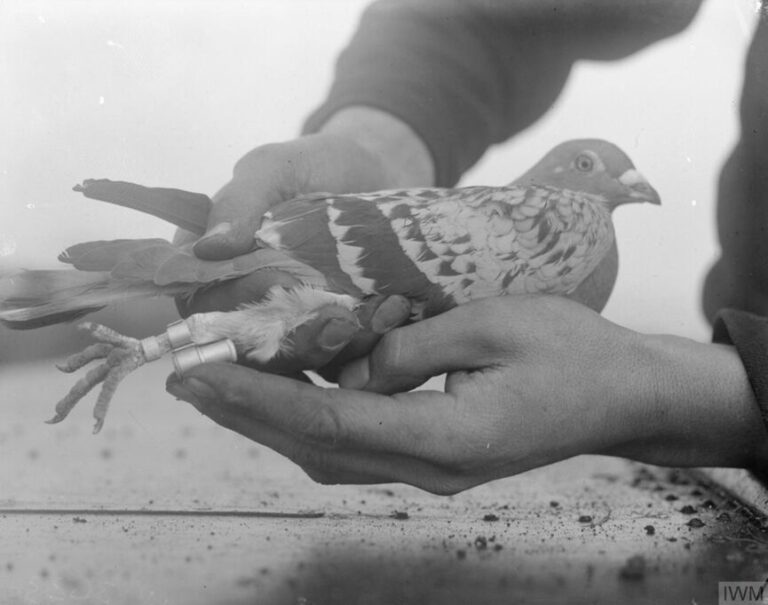Have you ever treated your pet for fleas, only to find them scratching again a few weeks later? You’re not alone. Many pet owners face this frustrating cycle of seemingly endless flea battles. The secret to winning the war against these persistent parasites lies in understanding one crucial fact: the flea lifecycle is far more complex than most people realise. It is vital to treat both your pet and your home together.
This blog will walk you through each stage of the flea lifecycle, explain why timing matters in flea treatment and provide practical strategies for effective flea prevention that actually work long-term.
The Lifecycle of a Flea
Understanding the flea lifecycle is essential for effective flea prevention and treatment. These resilient parasites progress through four distinct stages, each presenting unique challenges for pet owners trying to eliminate them from their homes. This handy diagram outlines what each part of the flea lifecycle looks like.

Egg Stage (50% of the flea lifecycle): The cycle begins when an adult female flea lays its eggs on your pet after feeding on their blood. An adult female can lay up to 50 eggs a day and as these eggs are not sticky, they fall off your pet’s fur and into your home, so you can see how an infestation can quickly take over!
Larvae Stage (35% of the flea lifecycle): When conditions are warm and humid (much like a classic British summertime) flea eggs begin to hatch into their larvae stage. These tiny, wormlike creatures are a slightly off-white colour and are as small as 1mm in length, making them tricky to spot. As they are light-phobic, they will seek out darker areas such as cracks, crevices and carpets. They survive by eating flea faeces otherwise known as flea dirt, and other organic debris in the home.
Pupae Stage (10% of the flea lifecycle): Once the flea larvae has moulted twice it will spin a cocoon and enter its pupae stage. This is when a flea is at its most protected and it can stay dormant for weeks, even months, evading your efforts to eradicate them. They are not only small but also have a sticky outer cocoon that attracts dust and debris for extra camouflage!
Adult Stage (5% of the flea lifecycle): When the time and conditions are right (warm temperatures, vibrations as pets/humans move past and carbon dioxide levels), the flea pupae will hatch into an adult flea. These small insects are 1-2mm in length and are more visible to the naked eye with a reddish-brown colouring. They begin feeding on their host within hours, can jump up to 150 times their body length and will begin reproducing within 24/48 hours. Although adult fleas only live for up to 21 days their long and robust reproductive lifecycle means a couple of fleas can become a full-blown infestation in a matter of days.
How long does a flea treatment take to work
The effectiveness and speed of flea treatments vary significantly depending on the type of product used and the extent of the infestation.
A fast-acting treatment like our 4Fleas tablets for cats and dogs can start killing adult fleas in as little as 15 minutes, however these only target the adult fleas that are on your pet. If you choose to treat your pet with tablets, you will need to follow up with a spot on treatment and an environmental spray will be required to eradicate the entire lifecycle in the home.
Our brand-new Guardian Plus Spot-On treatment works to kill adult fleas as well as prevent the development of eggs and larvae.
By preventing reinfestation and addressing every stage of the flea lifecycle, regular treatment ensures your pet stays safe and comfortable all year round.
How often do dogs/cats need flea treatment
The frequency of flea treatment depends on several factors, including your pet’s lifestyle, local flea population, and the type of products used.
Products like Guardian Plus Spot-On provide 4+ weeks of protection, making it ideal for a longer-term solution. This innovative new product range kills adult fleas and include ingredients that prevent flea development by targeting eggs and larvae.
Even indoor pets require flea prevention. Fleas can enter homes on clothing, other pets, or through open doors. Indoor environments provide ideal conditions for flea development, making prevention crucial, regardless of your pet’s outdoor exposure. Check out our blog on how indoor cats can get fleas for more information on treating your house cats and caring for small animals in summer for treating small furries.

How often should I treat my house for fleas
Regularly treating your home is essential for breaking the flea lifecycle and preventing reinfestations. During active flea infestations, daily vacuuming and regular washing of soft fabrics is crucial to remove eggs, larvae, and pupae.
Focus vacuuming on areas where your pet spends the most time, such as pet sleeping spots, feeding areas, and high-traffic zones such as hallways and lounge areas. Don’t forget to vacuum under furniture, along skirting boards and in floorboard cracks where eggs could accumulate. Vacuuming can stimulate dormant pupae to emerge, as the vibrations mimic a host’s presence, causing fleas to hatch into a treated environment, so it’s important to clean regularly even if you feel the infestation has been removed.
Washing all fabrics exposed to your pet is another key step. This includes pet bedding, blankets, sofa covers, and even your own bedding if your pet sleeps on your bed. Setting your washing machine to 60 degrees or higher will kill all flea life stages effectively. Additionally, environmental flea sprays, like Guardian Home Flea Spray, should be used regularly during infestations. These sprays kill adult fleas and prevent eggs and larvae from developing, offering up to six months of protection for pets and family.

Treating your home and your pet simultaneously is critical for success. Flea eggs and larvae can survive for weeks or months in ideal conditions, and pupae can remain dormant for up to 140 days. Without addressing both your pet and their environment, fleas can reappear even after treatment appears to have worked.
My dog/cat keeps getting fleas even after treatment
Recurring flea problems frustrate pet owners, but they’re usually the result of incomplete treatment rather than product failure. Several factors contribute to persistent flea infestations, and it’s important to remember that flea season is year-round, not just during the summer months.
Not properly treating your home is the most common cause of reinfestation, fleas will happily live at different stages in their lifecycle in your home. Treating your pet without addressing these environmental sources is like trying to empty a bath while the tap is still running. While pupae stage fleas can lay dormant in your home for long periods, they are easily awoken in warmer weather, you can read more about treating your home for fleas on our blog.
Another common cause of reinfestation is external factors such as your pet visiting the park and flea hitching a ride home, contact with another infested animal or even a trip to the groomers or kennels. As these are out of your control it can be easy for your pet to pick up these pesky little critters when they are out and about, another reason why one treatment just isn’t enough.
One treatment isn’t enough
In conclusion, consistency is key when it comes to effective flea prevention. Stopping treatments too soon can allow flea populations to return, often unnoticed until it’s too late. True prevention means staying ahead of the problem and ensuring fleas never have the chance to appear. By maintaining a treatment schedule that is tailored to your pet’s lifestyle, you can protect your pets and home from the challenges of a flea infestation.





